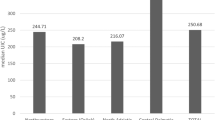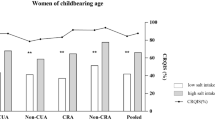Abstract
Background/Objectives:
Sweden has a long-standing salt iodization program; however, its effects on iodine intake have never been monitored on a national level. The objective of this study was to evaluate iodine nutrition in the Swedish population by measuring the urinary iodine concentration (UIC) in a national sample of Swedish school-age (6–12 years of age) children.
Subjects/Methods:
A stratified probability proportionate to size cluster sampling method was used to obtain a representative national sample of school-age children from 30 clusters. Spot urine samples were collected for UIC analysis using a modified Sandell–Kolthoff method.
Results:
The median UIC of the children (n=857) was 125 μg/l (range 11–757 μg/l). The proportion of children with a UIC <100 μg/l was 30.0% and the proportion of children with a UIC <50 and >300 μg/l was 5.5 and 3.0%, respectively.
Conclusions:
The iodine nutritional status of the Swedish population is adequate. Iodized table salt remains the main dietary source of iodine in Swedish diet. Recommendations to reduce total salt intake in the population urge increased use of iodized salt in the production of processed foods. Pregnant and lactating women with high iodine requirements may still be at risk for low iodine intake. This study will serve as the basis for future monitoring of iodine nutritional status in Sweden.
This is a preview of subscription content, access via your institution
Access options
Subscribe to this journal
Receive 12 print issues and online access
$259.00 per year
only $21.58 per issue
Buy this article
- Purchase on Springer Link
- Instant access to full article PDF
Prices may be subject to local taxes which are calculated during checkout

Similar content being viewed by others
References
Anonymous (2003). Iodine deficiency in Europe. National reports on iodine status in West-Central European countries. First symposium of ICCIDD West-Central Europe. Goteborg, Sweden, September 7, 2002. J Endocrinol Invest 26, 1–62.
Becker W (2000). Vilka är källorna till våra näringsämnen? Riksmaten 1997–98 (What are the sources to our nutrients? The second national food consumption survey 1997–98) (In Swedish). Vår Föda 52, 16–20.
Becker W (2003). Ät mindre salt (Eat less salt) (In Swedish). Vår Föda 55, 22–23.
Becker W, Lyhne N, Pedersen AN, Aro A, Fogelholm M, Thorsdottír I et al. (2004). Nordic Nutrition Recommendations 2004—Integrating nutrition and physical activity. In Nord 2004:13. Nordic Council of Ministers: Copenhagen.
Becker W, Pearson M (2002). Riksmaten 1997–98. Befolkningens kostvanor och näringsintag. Metod- och resultatanalys (The second national food consumption survey 1997−98. Dietary habits and nutrient intake in Sweden) (In Swedish). National Food Administration: Uppsala.
Berggren A (1816). Ämbetsberättelse (Civilservice report) (In Swedish). Svenska Läk Sällsk Handl 3, 34.
Bruce A (2007). Salta mindre en hjärtefråga för Livsmedelsverket (Reduce salt intake–a ‘heart’ issue for the National Food Administration) (In Swedish). Lakartidningen 104, 1016–1017.
Dahl L, Johansson L, Julshamn K, Meltzer HM (2004). The iodine content of Norwegian foods and diets. Public Health Nutr 7, 569–576.
de Benoist B, McLean E, Andersson M, Rogers L (2008). Iodine deficiency in 2007: global progress since 2003. Food Nutr Bull 28 (In press).
Delange FM (2003). Control of iodine deficiency in Western and Central Europe. Cent Eur J Public Health 11, 120–123.
Elnagar B, Eltom A, Wide L, Gebre-Medhin M, Karlsson FA (1998). Iodine status, thyroid function and pregnancy: study of Swedish and Sudanese women. Eur J Clin Nutr 52, 351–355.
Eltom A, Elnagar B, Elbagir M, Gebre-Medhin M (2000). Thyroglobulin in serum as an indicator of iodine status during pregnancy. Scand J Clin Lab Invest 60, 1–7.
Enghardt Barbieri H, Pearson M, Becker W (2006). Riksmaten—barn 2003. Livsmedels- och näringsintag bland barn i Sverige (Dietary habits and nutrient intake in Swedish children 2003) (In Swedish). National Food Administration: Uppsala.
European Community (1970). Council Directive 70/524/EEC concerning additives in feedingstuffs. CELEX-CEEUR Official Journal, pp 1–17.
Glinoer D (2007). The importance of iodine nutrition during pregnancy. Public Health Nutr 10, 1542–1546.
Gustavsson R, Sjoberg KH, Ostling G (1977). Jod och koksalt i urin hos ortsbefolkningen och anställda vid Oskarshamns kärnkraftverk (Iodine and common salt in the urine of local residents and employees at the Oskarshamn nuclear power station) (In Swedish). Lakartidningen 74, 3326–3328.
Gutekunst R, Smolarek H, Hasenpusch U, Stubbe P, Friedrich HJ, Wood WG et al. (1986). Goitre epidemiology: thyroid volume, iodine excretion, thyroglobulin and thyrotropin in Germany and Sweden. Acta Endocrinol (Copenh) 112, 494–501.
Hetzel BS (1983). Iodine deficiency disorders (IDD) and their eradication. Lancet 2, 1126–1129.
Höjer JA (1931) Kropfstudien. V. Die Verbreitung des endemischen Kropfes in Schweden (The goitre survey. V. The prevalence of endemic goitre in Sweden) (In German): Svenska läkarsällskapets handlingar.
Iwarsson K, Nyberg JA, Ekman L (1972). Samband mellan jodtillskott och jodhalt i mjölk hos mjölkkor (Correlation between iodine supplementation and iodine concentration in milk from dairy cows) (In Swedish). Nord Vet Med 24, 559–566.
Jarnerot G, Karlberg BE (1974). Jodbrist-alltjämt en realitet (Iodine deficiency-still a reality?) (In Swedish). Lakartidningen 71, 1019–1021.
Johnsson S (1965). Endemisk struma—frekvens i medelpad (Endemic goitre-average frequency in Medelpad). Lakartidningen 62, 2049–2056.
Kaiser R, Woodruff BA, Bilukha O, Spiegel PB, Salama P (2006). Using design effects from previous cluster surveys to guide sample size calculation in emergency settings. Disasters 30, 199–211.
Kungliga Medicinalstyrelsen (1936). Förebyggande åtgärder mot endemisk struma (Preventive measures for endemic goitre) (In Swedish). Medicinalväsendet 30.
Kungliga Medicinalstyrelsen (1966). Jodering av koksalt (Iodization of table salt) (In Swedish). Medicinalväsendet 11.
Larsson CL, Johansson GK (2002). Dietary intake and nutritional status of young vegans and omnivores in Sweden. Am J Clin Nutr 76, 100–106.
Li M, Chapman S, Agho K, Eastman CJ (2008). Can even minimal news coverage influence consumer health-related behaviour? A case study of iodized salt sales, Australia. Health Educ Res 23, 543–548.
Li M, Eastman CJ, Waite KV, Ma G, Zacharin MR, Topliss DJ et al. (2006). Are Australian children iodine deficient? Results of the Australian National Iodine Nutrition Study. Med J Aust 184, 165–169.
Lindmark-Månsson H, Fondén R, Pettersson HE (2003). Composition of Swedish dairy milk. Int Dairy J 13, 409–425.
Milakovic M, Berg G, Nystrom E, Lindstedt G, Gebre-Medhin M, Eggertsen R (2004). Urinary iodine and thyroid volume in a Swedish population. J Intern Med 255, 610–614.
Morreale de Escobar M, Obrego'n MJ, Escobar del Rey F (2007). Iodine deficiency and brain development in the first half of pregnancy. Public Health Nutr 10, 1554–1570.
National Food Administration (1983). Livsmedelsverkets föreskrifter om berikning av vissa livsmedel. (National Food Administrations recommendations for food fortification) (In Swedish) National Food Administration: Uppsala.
National Food Administration (1998). Riksmaten 1997–1998. Kostvanor och näringsintag i Sverige (The second national food consumption survey. Dietary habits and nutrient intake in Sweden 1997–98) (In Swedish) National Food Administration: Uppsala.
National Food Administration (2005). Svenska näringsrekommendationerna 2005 (SNR) (Swedish Nutrition Recommendations 2005 (SNR)) (In Swedish). 4th edn. National Food Administration: Uppsala.
National Food Administration (2007). Livsmedelsdatabasen (Swedish food composition database). National Food Administration: Uppsala.
Pearce EN (2007). National trends in iodine nutrition: is everyone getting enough? Thyroid 17, 823–827.
Pino S, Fang SL, Braverman LE (1996). Ammonium persulfate: a safe alternative oxidizing reagent for measuring urinary iodine. Clin Chem 42, 239–243.
Rasmussen LB, Carle A, Jorgensen T, Knudsen N, Laurberg P, Pedersen IB et al. (2008). Iodine intake before and after mandatory iodization in Denmark: results from the Danish Investigation of Iodine Intake and Thyroid Diseases (DanThyr) study. Br J Nutr 100, 166–173.
Sjoberg KH (1978). Jod och kosthåll (Iodine and diet) (In Swedish). Lakartidningen 75, 2477–2479.
Sjoberg KH, Sundlof G (1971). Strumasjukdomen fore och efter jodprofylaxen (The occurrence of struma before and after iodine prophylaxis) (In Swedish). Lakartidningen 68, 980–984.
Skeaff SA, Thomson CD, Gibson RS (2002). Mild iodine deficiency in a sample of New Zealand schoolchildren. Eur J Clin Nutr 56, 1169–1175.
Statistics Sweden (2003). Report MIS2003:1. Statistics Sweden (SCB): Örebro.
The European Parliament and the Council of the European Union (2006) Regulation (EC) No 1925/2006 of the European Parliament and of the Council of 20 December 2006 on the addition of vitamins and minerals and of certain other substances to foods: Official Journal of the European Union.
UNICEF (2008). The State of the World's Children 2008: Women and Children - Child Survival. United Nations Children's Fund: New York (NY).
Valsta M (2003). Iodine status of middle-aged subjects in Finland [abstract]. In: Spring meeting of the Finnish Society for Nutrition Research 2003. Finnish Society for Nutrition Research: Kuopio.
Vitti P, Delange F, Pinchera A, Zimmermann M, Dunn JT (2003). Europe is iodine deficient. Lancet 361, 1226.
WHO Secretariat on behalf of the participants to the Consultation Andersson M, de Benoist B, Delange F, Zupan J (2007). Prevention and control of iodine deficiency in pregnant and lactating women and in children less than 2-years-old: conclusions and recommendations of the Technical Consultation. Public Health Nutr 10, 1606–1611.
World Health Organization (1995). Physical Status: The Use and Interpretation of Anthropometry. Report of a WHO Expert Committee. Technical Report Series No. 854 World Health Organization: Geneva.
World Health Organization (2007a). Iodine Deficiency in Europe: A Continuing Public Health Problem. World Health Organization: Geneva.
World Health Organization, United Nations Children's Fund & International Council for the Control of Iodine Deficiency Disorders (1996). Recommended Iodine Levels in Salt and Guidelines for Monitoring Their Adequacy and Effectiveness. World Health Organization: Geneva.
World Health Organization, United Nations Children's Fund & International Council for the Control of Iodine Deficiency Disorders (2007b). Assessment of Iodine Deficiency Disorders and Monitoring Their Elimination. A Guide for Programme Managers, 3rd edn. World Health Organization: Geneva.
World Medical Association (2001). World Medical Association Declaration of Helsinki: ethical principles for medical research involving human subjects. Bull World Health Organ 79, 373–374.
Zimmermann MB (2007). The adverse effects of mild-to-moderate iodine deficiency during pregnancy and childhood: a review. Thyroid 17, 829–835.
Zimmermann MB, Aeberli I, Torresani T, Burgi H (2005). Increasing the iodine concentration in the Swiss iodized salt program markedly improved iodine status in pregnant women and children: a 5-y prospective national study. Am J Clin Nutr 82, 388–392.
Zimmermann MB, Connolly K, Bozo M, Bridson J, Rohner F, Grimci L (2006). Iodine supplementation improves cognition in iodine-deficient schoolchildren in Albania: a randomized, controlled, double-blind study. Am J Clin Nutr 83, 108–114.
Zimmermann MB, Jooste PL, Mabapa NS, Mbhenyane X, Schoeman S, Biebinger R et al. (2007). Treatment of iodine deficiency in school-age children increases insulin-like growth factor (IGF)-I and IGF binding protein-3 concentrations and improves somatic growth. J Clin Endocrinol Metab 92, 437–442.
Acknowledgements
We thank the headmasters, teachers, nurses and children in the participating schools. The support of Å Bruce at the National Food Administration, Uppsala, is gratefully acknowledged. We also thank MB Zimmermann at the Swiss Federal Institute of Technology Zürich for technical guidance. This study was supported by Sahlgrenska University Hospital, Sahlgrenska Academy, University of Gothenburg, Gothenburg, Sweden.
Author information
Authors and Affiliations
Corresponding author
Additional information
Guarantor: E Nyström.
Disclosure statement
The authors have nothing to disclose.
Rights and permissions
About this article
Cite this article
Andersson, M., Berg, G., Eggertsen, R. et al. Adequate iodine nutrition in Sweden: a cross-sectional national study of urinary iodine concentration in school-age children. Eur J Clin Nutr 63, 828–834 (2009). https://doi.org/10.1038/ejcn.2008.46
Received:
Revised:
Accepted:
Published:
Issue Date:
DOI: https://doi.org/10.1038/ejcn.2008.46
Keywords
This article is cited by
-
Iodine status five years after the adjustment of universal salt iodization: a cross-sectional study in Fujian Province, China
Nutrition Journal (2021)
-
A randomized, double-blind study of iodine supplementation during pregnancy in Sweden: pilot evaluation of maternal iodine status and thyroid function
European Journal of Nutrition (2021)
-
Iodine deficiency in pregnant women in Sweden: a national cross-sectional study
European Journal of Nutrition (2020)
-
Correlations of water iodine concentration to earlier goitre frequency in Sweden—an iodine sufficient country with long-term iodination of table salt
Environmental Health and Preventive Medicine (2019)
-
Iodine status in Norwegian preschool children and associations with dietary iodine sources: the FINS-KIDS study
European Journal of Nutrition (2019)



